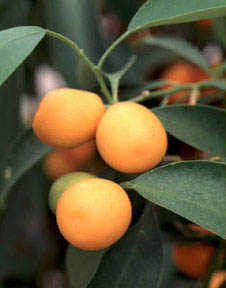It is a slow-growing, evergreen shrub or small tree,
from 2.5-4.5 m tall, with dense branches, sometimes bearing small thorns. The leaves are dark glossy green, and the flowers pure white, similar to citrus flowers, borne singly or clustered in the leaf-axils.Kumquats originated in China (noted in literature there in the 12th century), and have long been cultivated there and in Japan. They were introduced to Europe in 1846 by Robert Fortune, collector for the London Horticultural Society, and shortly thereafter into North America. Originally placed in the genus Citrus, they were transferred to the genus Fortunella in 1915.
There are four species currently accepted, include Hong Kong Wild Kumquat (Fortunella hindsii), Marumi Kumquat (Fortunella japonica), Meiwa Kumquat (Fortunella crassifolia), and Nagami Kumquat (Fortunella margarita). They are cultivated in China, South East Asia, Japan and the USA. Kumquats are much hardier than citrus plants such as oranges.
The fruit
The fruit of the kumquat is also called kinkan. In appearance it resembles a miniature oval or oblong orange, 3-5 cm long and 2-4 cm wide. Depending on variety, peel color ranges from yellow to red. A Nagami kumquat is oval and has a yellow skin, while a Marumi kumquat is round with an orange-colored skin.
Kumquats are frequently eaten whole — the skin is sweet and the inner fruit tart. The juicy center is often too sour to eat and is thrown away after the rind is nibbled off and consumed. The fruit is considered ripe when it reaches a yellowish-orange stage, and has just shed the last tint of green. A variety of kumquat in Hong Kong has rather sweet rind compared to the rind of other citrus fruits.
Culinary uses include: candying and kumquat preserves, marmalade, and jelly. Kumquats appear more commonly in the modern market as a margarita garnish, replacing the classic olive.
Kumquat fruit is generally in season from late November to February, and can be found in most food markets with other produce.
A Cantonese recipe
The Cantonese often preserve kumquats in salt. A batch of the fruit is buried in dry salt inside a glass jar. Over time, all the juice from the fruit is extracted through osmosis into the salt. The fruits in the jar will become shrunken and wrinkled in dark brown color, and the salt will become a dark brown brine. A few salted kumquats and a few teaspoonsful of the brined juice are mixed with hot water to make a remedy for sore throat. A jar of such preserved kumquats can last several years.
| Kumquat | ||||||||||||
|---|---|---|---|---|---|---|---|---|---|---|---|---|
| Scientific classification | ||||||||||||
| ||||||||||||
| Species | ||||||||||||
|
Fortunella crassifolia - Meiwa Kumquat |

